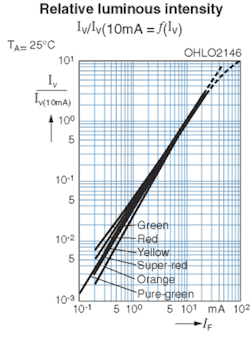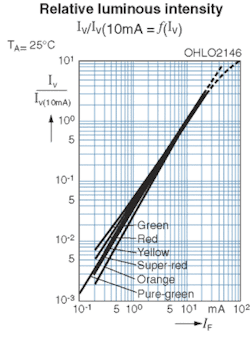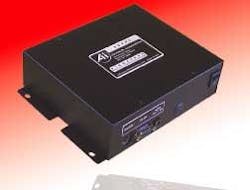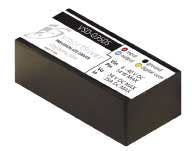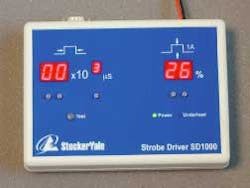Smart controllers intensify LED lighting
By choosing the correct combination of LED lighting and controllers, systems integrators can solve illumination problems.
By Andrew Wilson, Editor
According to Keith Scott, business development manager for Lumileds Lighting, LEDs currently represent the illumination source in roughly half of the machine-vision systems on the market. There are several reasons for this, including their small form factor, long life, ruggedness, rapid xenon-equivalent strobing capabilities, and ability to deliver monochromatic light that eliminates inaccurate measurements caused by chromatic distortion.
"Luxeon-based lights for machine-vision systems now represent 90% of what we sell because of their higher performance compared with other LED-based lighting assemblies," says Matt Pinter, chief design engineer with Spectrum Illumination, which uses the devices in its Monster Light Series of spotlights, ringlights, and linear arrays for machine-vision systems. "This is opening new markets for us," he says, "particularly in the robotics industry, where the camera must be eight or ten feet away from the assembly line."
LIGHTING METHODS
With interest now being shown in LED illumination, systems designers can choose from a number of different lighting configurations with which to attack machine-vision problems. Customized components and products with white, blue, green, and yellow LEDs are available, as well as devices that emit radiation in the ultraviolet and infrared wavelengths. This large number of choices is especially useful when colored objects need to be imaged. In such cases, the wavelength of illuminated light can become a critical factor in obtaining a correct image.
"Many companies offer lighting products that use red LEDs for illumination," says Jim Fishburn, general manager of the inspection department at Omron Electronics. "While red LED lighting works well for reflective surfaces such as solder paste and masks out many other nonreflective elements and features, using color LED lighting in such applications may provide an even greater advantage." Gray-scale systems often have difficulty differentiating between a solder bridge and a silk-screen line, which may result in poor quality assurance. "But illuminating the PCB using color LED lighting would allow a color machine-vision system to differentiate among the variety of colors on a PCB, including the substrate color, component color, and the silk screen color," he says.
Depending on the type of object that must be imaged, systems developers generally experiment with different types of illumination methods, which essentially include backlighting, ringlighting, dark-field illumination, and light diffusion (seeVision Systems Design, August 1999, p. 47). For each illumination method, LED lighting vendors offer several products. For example, if the edges of an object are the most critical feature to be measured, an LED backlight could be used. If surface defects on specular surfaces need to be examined, systems developers could use an off-axis ringlight to illuminate the object with a horizontal (dark-field) plane of light. Where highly reflective specular surfaces need to be examined, diffuse dome lighting may prove the answer. To aid in choosing the correct product for a specific application, many LED lighting companies, including RVSI/NER, have developed comprehensive tutorials that can be accessed from their Web sites.
"Building such illumination systems using conventional light sources and fiberoptics is completely impractical for several reasons," points out Dimitry Gorelik, director of research and development at Navitar. These include the relative size of conventional light sources, heat-dissipation problems, and the high cost of fiberoptic illumination systems. "It is," he says, "relatively easy to develop such illumination systems using LEDs as the light source."
DRIVING LED LIGHTS
Although there are many ways to illuminate objects using LEDs, designers must take extra care when specifying how such lights are driven. According to Gardasoft Vision, early deployments used off-the-shelf voltage sources to control the intensity of LED lighting systems. With such systems, even slight changes in voltage can result in great variation of the output intensity. For example, in the LS-3340 Super red series of LEDs from Osram Opto Semiconductors, the light output varies with current (see Fig. 1).
To control products based on such devices, vendors such as Gardasoft offer LED controllers that provide a digitally controlled constant current output, accurate pulse timing with variable delay and pulsewidth, and selectable intensity. Gardasoft's PP600 controller, for example, enables output current and pulse timing to be set manually or dynamically from software, permitting commonly used settings to be repeated.
Automatic or manual calibration of lighting intensity can prevent system degradation over a period of time. Once a day, the lighting is activated and the brightness of the particular region in the camera's field of view is measured. If the brightness is reduced due to aging or dirt buildup on the light, the lighting intensity can be increased by a small amount and again measured until the target brightness is achieved.
SPECIFYING PARAMETERS
In choosing a specific controller for a lighting application, systems integrators must specify such parameters as whether intensity control is required, whether the controller should be programmable, whether individual light channels need to be controlled separately, and whether strobe lighting with more than one output or individual output triggers are required. In its line of Signatech smart LED controllers, Advanced Illumination offers many controllers that can be used to meet all of these parameters (see Fig. 2). With an automatic configuration and optimization technology, the light that is connected is automatically identified by the current source, and internal power settings are adjusted to ensure both maximum intensity and lifespan. For lights without a Signatech signature inside, the controllers default to a specified current setting.
By adding such intelligence to lighting products and controllers, Advanced Illumination eases the task of systems developers who, in the past, were required to match one company's off-the-shelf lights with another's power supply. Adding intelligence to these peripherals is now the main aim. Such illumination systems can be automatically monitored for the correct illumination, correctly strobed, and even networked over industrial networks.
Microview Technologies specializes in the design and development of vision systems, digital cameras, and illumination systems. Its line of illumination light heads includes integrated LED front and dome lighting peripherals. To control these devices, the company also offers a programmable LED pattern-and-intensity controller designed specifically for the inspection of semiconductor parts. To control the lighting intensity and switching lighting patterns with these lights, the company offers the ProStar, a programmable I/O-driven lighting controller.
In addition, the company has recognized the importance of monitoring the intensity of the lights in operation. Because of this, it has added a light-failure-monitoring module to its ProStar line. The monitor is matched with a specific type of light head to establish a closed-loop adaptive lighting system. The module detects light failure, and a series of outputs alert the host machine-vision system.
INTELLIGENT LIGHTING
Adding intelligence to LED lighting is just one way that developers are offering more benefits to the systems integrator. Because many industrial-automation systems require multiple networked machine-vision systems to provide numerous inspection tasks, some vendors are also incorporating this functionality into their lighting controllers.
Integrated Illumination Systems has recently introduced an intelligent controller that can address individual drivers through various network protocols such as RS-485 or Ethernet, allowing every LED fixture or array on the network to be controlled (see Fig. 3 on p. 69). In this way, light-source selection, color mixing, programmable LED intensity, and the grouping of fixtures all can be achieved from a remote location. The company also offers options such as 0%–100% dimming by controlling the current or by pulsewidth modulation of the LEDs using the embedded microcontroller of the LED controller.
These embedded controllers not only help detect illumination failure and add networking capability to machine-vision systems, but can increase the effective brightness of LED lamps in a pulsed or strobe operation. This is useful in machine-vision applications, where objects may be moving at high speed and can be imaged using stroboscopic illumination controllers.
A number of companies manufacture such products. The SD1000 strobe driver from StockerYale, for example, can be used to drive its line of ring, line, area, and spotlights (see Fig. 4 on p. 69). Although these lights are set to run from a 24-V supply and draw approximately 0.2 A, their brightness can be increased using the SD1000—a unit that operates from a 48-V supply and that can provide a current up to 1 A at a maximum duty cycle of 10%.
Using StockerYale's illumination products with the controller produces a brightness increase of between four and five times. Intended to be a laboratory instrument for setting optimum driving conditions, the company recommends the use of a custom strobe driver when OEMs decide to drive a large number of illuminators.
LED lighting now plays a large role in illuminating parts for machine-vision systems. To help OEMs decide on which type of lighting is best for their specific application, lighting vendors offer a range of products from diffuse backlighting to cloudy-day illuminators. To understand their difference, many vendors offer helpful tips on their Web sites, often showing numerous parts illuminated in different ways. After deciding on which lamp best meets their application requirements, however, developers should also understand the differences between the intelligent LED controllers that are on the market and whether such features as automatic configuration, software support, strobing, networking, and safety-failure mechanisms are required.
Company Info
Advanced Illumination, Rochester, VT, USA www.advancedillumination
Gardasoft Vision, Cambridge, UK www.guardasoft.com
Integrated Illumination Systems, Morris, CT, USA www.i2systems.com
Lumileds Lighting, San Jose, CA, USA www.lumileds.com
Microview Technologies, Kallang Basin Industrial Estate, Singapore www.micro-view.net
Navitar, Rochester, NY, USA www.navitar.com
Omron Electronics, Schaumburg, IL, USA oeiweb.omron.com
Osram Opto Semiconductors, Regensburg, Germany www.osram-os.com
RVSI/NER, Weare, NH, USA www.nerlite.com
Spectrum Illumination, Muskegon, MI, USA www.spectrumillumination.com
StockerYale, Salem, NH, USA www.stockeryale.com
